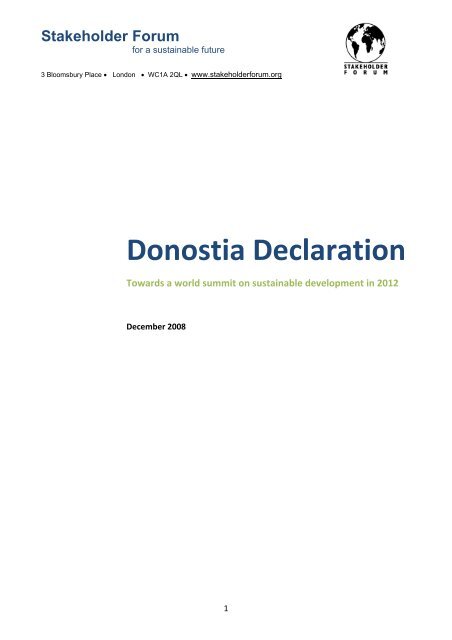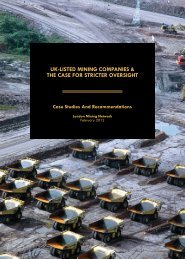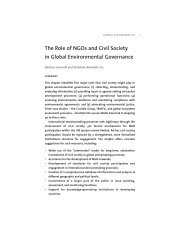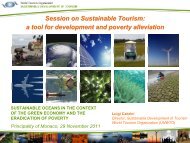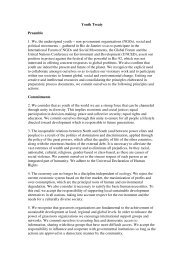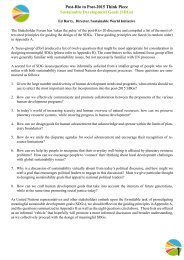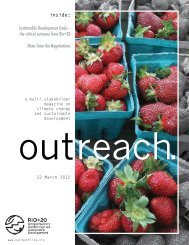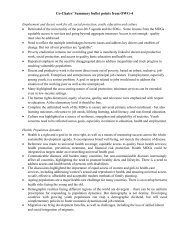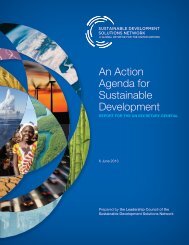Donostia Declaration - Stakeholder Forum
Donostia Declaration - Stakeholder Forum
Donostia Declaration - Stakeholder Forum
You also want an ePaper? Increase the reach of your titles
YUMPU automatically turns print PDFs into web optimized ePapers that Google loves.
<strong>Stakeholder</strong> <strong>Forum</strong>for a sustainable future3 Bloomsbury Place London WC1A 2QL www.stakeholderforum.orgINTRODUCTION“I amreminded inwriting thisthat the futureis not a gift –but anachievement”“It is surely atime forboldness, forpassion, forvision and forcommitment tocreate a betterand moresustainablefuture”On 13 th – 14 th November 2008, representatives of governments,stakeholders and the UN were invited to San Sebastian, Spain, to considerthe possibility of a World Summit on Sustainable Development in 2012. Onthe 4 th of November, the G‐77 and China tabled a motion in the UnitedNations General Assembly calling for such a Summit. This paper is acollection of the views expressed at the meeting. It forms a ‘Non Paper’intended to stimulate discussion on the focus and structure of such aSummit.I am reminded in writing this that the future is not a gift – but anachievement. Every previous generation has strived for a better and moresecure world. The challenge for this generation is to strive for a bigger goal:that of a sustainable world. It is not a time for complacency to be contentwith today, or be timid or apathetic in the face of the challenges the worldfaces: business as usual is no longer an option. It is surely a time forboldness, for passion, for vision and for commitment to create a better andmore sustainable future. As Einstein said:"We can't solve problems by using the same kind of thinking we used whenwe created them."The workshop was addressed, in person, by experts in policy and process,and veterans of previous sustainable development conferences. Theworkshop was also addressed via interactive video by Nitin Desai, formerSecretary General of the Johannesburg World Summit on SustainableDevelopment [from Delhi]; John Scanlon, Principal Advisor, Policy andProgramme Team Leader, Strategic Implementation Team, Executive Office,UNEP [from Nairobi]; Olivier Deleuze, Chief, Major Groups and <strong>Stakeholder</strong>sBranch Division of Regional Cooperation, UNEP [from Nairobi]; RémiParmentier, Director of the Varda Group [from Madrid]; and RichardSherman, governance advisor, <strong>Stakeholder</strong> <strong>Forum</strong>, and Programme Managerand Content Editor, IISD [from New York].2
<strong>Stakeholder</strong> <strong>Forum</strong>for a sustainable future3 Bloomsbury Place London WC1A 2QL www.stakeholderforum.orgThe workshop was organized by <strong>Stakeholder</strong> <strong>Forum</strong>. It was made possible bythe financial support of the Basque regional Government and logisticalsupport by IHOBE, IT consultancy Proyelia, the International Court ofEnvironmental Arbitration and Conciliation Office of San Sebastian, and theoffice of the San Sebastian Film Festival. In particular I would like to thankRichard Black, Ibon Galarraga, Rémi Parmentier, Derek Osborn, VirginiaPrieto, Hannah Stoddart, Michael Strauss, Genevieve Verbrugge and DavidWoollcombe, for the help they have given to organise the workshop and theproduction of the <strong>Donostia</strong> <strong>Declaration</strong>.Felix DoddsExecutive Director<strong>Stakeholder</strong> <strong>Forum</strong> for a Sustainable Future3
<strong>Stakeholder</strong> <strong>Forum</strong>for a sustainable future3 Bloomsbury Place London WC1A 2QL www.stakeholderforum.orgDONOSTIA DECLARATION“Promoting development on a sustainable basis continues toconstitute the only permanent and effective instrument for theestablishment of peace, security and prosperity for individual countriesand the international community as a whole.We must not lose sight of this. We must create a new paradigm ofinternational cooperation that takes into account the new globalchallenges and realities.”Celso Amorium, Foreign Minister, BrazilVISION“We can do it – Yes we can”President Elect Barack ObamaThe Earth Summit in 1992 in Rio de Janiero was a major success. It identifiedthe vast range of environmental, economic and social impacts threateningglobal ecosystems and human populations, and it integrated the complexagenda necessary to achieve sustainable development that could alleviatethose threats. It convinced most of the world’s policy makers and much ofthe public of the imminent threats facing all of us, and most importantlytriggered the momentum for the adoption of the Rio Conventions onClimate Change and Biological Diversity.The World Summit on Sustainable Development in Johannesburg [2002]pioneered specific strategies to include businesses and other stakeholders insustainability program implementation – and particularly focused on theurgent problems of Africa. It took an additional step in convincing economicleaders to accept the need for implementing sustainable practices.4
<strong>Stakeholder</strong> <strong>Forum</strong>for a sustainable future3 Bloomsbury Place London WC1A 2QL www.stakeholderforum.org“..major newand urgentchallenges haveemerged thatdirectlythreaten localpopulations,regionalecosystems,nationaleconomies andthe planetitself”“..The widescaleadoptionand integrationof sustainabledevelopmentprinciplesenvisaged inAgenda 21 hasnot happenedon anything likethe scaleneeded.”Two years earlier, the Millennium Development Summit [2000] prioritisedachieving ambitious, tangible development goals for the world’s poorestpopulations, and it included sustainable strategies in its agenda forimplementing them.Since those summits, however, major new and urgent challenges haveemerged that directly threaten local populations, regional ecosystems,national economies and the planet itself.In the past two years, crises in Food Availability and in Energy Securityemerged almost unanticipated and impacted both developed anddeveloping countries. For almost a decade, extreme and erraticmeteorological events – floods, droughts, heat waves, hurricanes andmonsoons – have inundated coastlands, drowned cities, disruptedagriculture, instigated famines, spurred wildfire, caused near ‐permanentdust storms in certain regions, and led to the collapse of glaciers, ice capsand polar ice shelves that have stood intact for centuries. Their catastrophicimpacts on human populations and ecosystems have occurred at anaccelerated pace, beyond the worst‐ case scenarios of the IPCC.Today, the international financial crisis threatens the stability of everynation’s economic system. The crisis reveals the risks posed by uncontrolledeconomic globalisation, and the potential negative impacts on environmentand development goals. It also illustrates the results of a total failure tointegrate environmental, social and development priorities into globaleconomic policy.Furthermore the problems addressed at the Rio Earth Summit in 1992 havenot been solved. Dangerous climate change has not been averted, the globalloss of biodiversity has not been curbed and desertification has not beenslowed. The wide‐scale adoption and integration of sustainabledevelopment principles envisaged in Agenda 21 has not happened onanything like the scale needed. Despite the success of Rio as a summit withclear outcomes, those outcomes have not been transformed into real‐worldchange.5
<strong>Stakeholder</strong> <strong>Forum</strong>for a sustainable future3 Bloomsbury Place London WC1A 2QL www.stakeholderforum.org“..[We] needto engage in anewpartnershipfor sustainabledevelopment –a blueprint forsustainabledevelopment,lookingforward to2030.”The failure to implement agreed commitments, combined with theemergence of new challenges has substantially increased the threat tointernational peace and security and our survival on the planet itself. Thesechallenges need urgently to be addressed, not only individually, but in anintegrated model that provides a comprehensive new approach for the nextfew decades.To address the challenges, UN agencies, national governments, civil societystakeholders and the general public need to engage in a new partnership forsustainable development – a blueprint for sustainable development, lookingforward to 2030. These challenges also require an empowered mandate andan activist agenda by the international community tasked with monitoringand encouraging sustainable development.WHY A SUMMIT IN 2012?"God forbid that India should ever take to industrialisation after themanner of the West. The economic imperialism of a single tiny islandkingdom (the UK) is today keeping the world in chains. If an entirenation of 300 million took to similar economic exploitation, it wouldstrip the world bare like locusts."Mahatma Gandhi (1928)A Summit must look forward to 2030 – a significant date in the report of theIntergovernmental Panel on Climate Change [2007] for stabilising GHGemissions. It is likely that this will also become the target for the next set ofMillennium Development Goals [i.e. 2015‐2030]. These goals will need toactively incorporate sustainable development principles. An Earth Summit in2012 will help to ensure that this agenda is achievable, through creating anew and compelling vision of sustainable development for the 21 st century.6
<strong>Stakeholder</strong> <strong>Forum</strong>for a sustainable future3 Bloomsbury Place London WC1A 2QL www.stakeholderforum.org“A Summitshould addressthe impactthatuncontrolledglobalisationis having onthe ability ofall people tolivesustainabilityon ourcommonplanet”Overall, a Summit should address the impact that uncontrolled globalisationis having on the ability of all people to live sustainably on our commonplanet. It should be the occasion for endorsing new binding agreements onkey issues, undertaking new financial commitments, underpinning this witha global Green New Deal and reshaping global governance arrangements forsustainable development.Politically, it seems that the time for a new global consensus is ripe. A newgeneration of national leaders is arriving; none of the G8 country Presidentsor Prime Ministers who attended the Johannesburg Summit will be in officein 2012. Over the next four years, there will be new issues demandingurgent attention, new ideas for coordinated action to address them, and anew willingness to implement them. There will be potentially high interest ina global platform that can be utilized to project vision and leadership.There is support for the idea that the Summit be a Heads of State andGovernment meeting, that it be a stand‐alone event, and that it be held in adeveloping country. In recent years governments have moved away fromthe multiple summits of the 1990’s to organizing events at the UN HQ inNew York. However, these events exclude global civil society and a greatdiversity of stakeholders – many of whom are the individuals andorganisations needed to implement any agreement. Moving instead to anintegrated summit process could not only bring the new ideas needed, butalso bring energy and commitments from stakeholders to play an active andcritical role in shaping and implementing agreements as they evolve.7
<strong>Stakeholder</strong> <strong>Forum</strong>for a sustainable future3 Bloomsbury Place London WC1A 2QL www.stakeholderforum.orgA GLOBAL GREEN NEW DEAL“A nation that destroys its soils destroys itself. Forests are the lungsof our land, purifying the air and giving fresh strength to our people.”President Franklin D. Roosevelt“Integratingeconomic,environmentaland socialsustainabilityand thepromotion ofnatural andculturaldiversityshould be theorganisingprinciples forthe 21stcentury”In this new millennium, the world needs a new and challenging vision forachieving sustainable development, based on green, prosperous andequitable societies, rather than returning to the unsustainable productionand consumption patterns of the past. The current economic crisis offers theopportunity to adopt a new development paradigm that leads to a liveableworld, where all of its people and countries feel they are recognized asstakeholders with a share in the planet.Economic globalization and uncontrolled free trade has been the organisingprinciple of international economics until this point. Integrating economic,environmental and social sustainability and the promotion of natural andcultural diversity should be the organising principles for the 21 st century.This is the only way to make use of the innovative mechanisms required todeal with the critical challenges presented by the current economic modelwhich has resulted in an increased disparity between rich and poor,accelerated climate change; desertification, loss of biodiversity; degradationof ecosystems; and threats to food, water and energy security.The financial crisis presents a real and tangible opportunity to reform theBreton Woods Institutions around the promotion of sustainabledevelopment. A reformed World Bank and International Monetary Fund thathave at their hearts the promotion of sustainable development wouldensure more socially equitable, economically stable and environmentallysound global development. An ‘International Sustainable DevelopmentFund’ (ISDF) and a ‘World Sustainable Development Bank’ would go a longway to ensure a more sustainable approach to global development andfinance.8
<strong>Stakeholder</strong> <strong>Forum</strong>for a sustainable future3 Bloomsbury Place London WC1A 2QL www.stakeholderforum.orgThe transparency and accountability of multinational companies has beenmade clear by the financial crisis. In this context, the adoption at theSummit of a Convention on Corporate Social and EnvironmentalResponsibility concerning companies listed on the stock markets could be amilestone. This might include incorporating the Global Reporting Initiativeand the Global Compact Principles as mandatory.To mobilise new thinking the UN Secretary General should explore thepossibility of a World Commission on the Green New Deal which wouldreport to the Summit process in 2011 and 2012.MOBILISATION“Earth Summitin 2012 offersthe platformfor globalstakeholdersto worktowardscommon goalsthat transcendnationalboundaries”“Multi‐<strong>Stakeholder</strong> Processes are a new species in the political ecosystem.They will make mistakes. They will not solve all problems toeveryone’s satisfaction. MSPs should not and will not provide analternative to good government. But they might help it – and the restof us ‐ make the necessary progress towards sustainability.” Heconcluded his presentation by giving an alternative definition ofMSPs: “Making the Sum greater than the Parts”.Paul Hohnen, former Strategic Director GreenpeaceAn Earth Summit in 2012 offers the platform for global stakeholders to worktowards common goals that transcend national boundaries. It cannot andshould not be built without broad and grassroots public supportIf Earth Summit 2012 is to be a watershed, it requires a communicationstrategy that addresses and involves “real” people. The realities of theglobalized world and the opportunities presented by the revolution in globalcommunications allow groups of people with common concerns andinterests to link up and mobilise to push for change. Earth Summit 20129
<strong>Stakeholder</strong> <strong>Forum</strong>for a sustainable future3 Bloomsbury Place London WC1A 2QL www.stakeholderforum.orgshould be more than an intergovernmental process – it should be a focalpoint for mass mobilisation of a broad range of stakeholders around theworld, from regional and local governments, to cities, businesses, tradeunions, NGOs and all other Major Groups identified by Agenda 21 and otherstakeholders.These constituencies need to be engaged and involved not just as lobbyistsbut as actors in their own right, capable of making their own proposals for,and pledges to, the sustainable development of the future – this allowsinnovations to arise that complement and reinforce internationalobligations. It offers a chance over the next three years to explore andcreate new partnerships for sustainable development to become a driver forreal change in implementing agreements.EDUCATION FOR SUSTAINABLE DEVELOPMENT“We need a new environmental consciousness on a global basis. Todo this, we need to educate people”“Earth Summitin 2012 offersthe platformfor globalstakeholdersto worktowardscommon goalsthat transcendnationalboundaries”Mikhail GorbachevIn the preparation of Agenda 21, Maurice Strong realised too late that animportant major group he had failed to identify and engage was theeducators. In later years, he would say often that the key to implementationof Agenda 21 lay in education. Yet so far the international community hasfailed to “Re‐orient education towards sustainable development” as Agenda21, Ch. 36 demanded. Instead, educational institutions continue to trainengineers, business people and service industry professionals whosevaluable skills nonetheless fail to meet the challenge of designing a lowcarboneconomy. The 2012 Summit process will offer an opportunity tomake a concerted effort to engage, and be guided by, the EducationCommunity in an initiative to design an education system better geared tothe creation of a sustainable, post‐carbon green economy. The preparatory10
<strong>Stakeholder</strong> <strong>Forum</strong>for a sustainable future3 Bloomsbury Place London WC1A 2QL www.stakeholderforum.orgprocess will also seek more seriously to engage the young people whosefuture the 2012 Summit is ultimately designed to secure and protect.COMMUNICATION AND DEVELOPMENT“Web 2.0 may not be social media, but it is the fundamentalinfrastructure.”Auren Hoffman, Rapleaf“The globalcommunications revolutionoffers anunprecedentedopportunity foran EarthSummit tomobilise peopleall over theworld to worktogether and tomonitorgovernments’accountability”A global summit provides broad opportunities to catch the imagination ofthe world’s public, to build political constituencies in support of progressiveand creative programs, and to motivate individuals to take personal action.An Earth Summit in 2012 should include bold, colourful and effective visualimagery. It should strive for a small environmental foot print, but a hugeemotional foot print. An action‐oriented Summit should emphasize positivescenarios that are available, affordable and achievable through concertedaction – not just the catastrophic results that will be the effect of business asusual.Until now, high‐level political processes have had a tendency to be thepreserve of an elite, or those ‘in‐the‐know.’ The global communicationsrevolution offers an unprecedented opportunity for an Earth Summit tomobilise people all over the world to work together and to monitorgovernments’ accountability. The use of targeted interactive techniques ofpublic engagement [e.g. Web 2.0 technology, or by then 3.0 or 4.0] canallow individuals to feel ownership of strategies and campaigns, and to begiven access to an international policy‐making arena that has traditionallyeluded them: the recent campaign of President Elect Barak Obama hasshown how new media can be harnessed to instigate mass participation.An expanded use of print media, television and radio broadcasting– at bothan international and a local level and in various languages ‐ can also beutilized to empower individuals and communities to act and to realize howthe goals of an Earth Summit are relevant to them.11
<strong>Stakeholder</strong> <strong>Forum</strong>for a sustainable future3 Bloomsbury Place London WC1A 2QL www.stakeholderforum.org“..there is nowa newgeneration ofyoung peoplewho will beadverselyaffected by thefailure toachieve globalsustainabledevelopment,and who aredemanding abetter future”We must take advantage of the generational shift: by 2012 there will be alarge number of business leaders who need to be engaged in the globalsustainable development agenda, having only been junior professions duringthe time of the first Earth Summit in 1992 ‐ these individuals will bepresented with the opportunity to be successful where their predecessorsfailed or had no opportunity. Furthermore, there is now a new generation ofyoung people who will be adversely affected by the failure to achieve globalsustainable development, and who are demanding a better future. Theseindividuals were either too young to be politically aware, or not even born in1992. They deserve to have their voices heard: a World Summit offers themthat opportunity, and any preparatory process should harness the energy ofthis constituency of people.INTERNATIONAL GOVERNANCE AND THE ENVIRONMENT: THENEED FOR TRANSFORMATIONAL CHANGE“..The mismatchbetween currentglobal problemsand theinstitutions thatexist to deal withthem requirestransformationalchange”“Civil Society is in agreement that the international environmental regimeis dogged by the lack of political will to resolve environmental problemscoherently and to follow a policy for the sustainable use of the earth'sresources. This has led to a fragmentation of the environmental agenda,limited financial resources, poor enforcement of MultilateralEnvironmental Agreements as well as an imbalance between internationalenvironmental governance and other international trade and financialregimes.”Richard Sherman, <strong>Stakeholder</strong> <strong>Forum</strong>, at the UN GA Informal Session 10 thDecember 2007It is becoming increasingly evident that the current international governancearchitecture is not sufficient for dealing with the economic, social andenvironmental challenges that the world faces. The mismatch between12
<strong>Stakeholder</strong> <strong>Forum</strong>for a sustainable future3 Bloomsbury Place London WC1A 2QL www.stakeholderforum.orgcurrent global problems and the institutions that exist to deal with themrequires transformational change – the need for developing a coherentinternational governance structure could not be more urgent, dealing withinternational finance, trade, long‐term investments and environment in anintegrated and holistic way.The Summit must address the following governance issues:“..Planet Earth iscurrently lackingleaders, and hasbeen left largelyundefended.” Reform of International Environmental Governance Reform of UNEP – should it be reformed into a body similar to UNDP,or a United Nations Environmental Organisation? Clustering of Multilateral Environmental Agreements Balancing of the unequal relationship between MEAs and the WTO Reviewing the sustainable development architecture and how tomainstream sustainable development throughout the UN system so itbecomes its guiding principle ‐ perhaps with a SustainableDevelopment Council in the General Assembly.An Earth Summit in 2012 should create the global institutional frameworkwe need to take us forward in the first half of the 21st century. An EarthSummit has the potential to create new leadership in this area. Planet Earthis currently lacking leaders, and has been left largely undefended.GLOBAL GOALS"...if we are to make significant progress on meeting these Goals and staytrue to the promise the world made to build a better, fairer world for all,there is no time to lose in putting in place the necessary policies andresources needed to achieve these aims."Kemal Dervis, Administrator UNDPThere is an urgent need for a set of goals and standards around which allcountries can cohere in relation to sustainable development. TheMillennium Development Goals have served as a powerful tool for buildingaccountability and momentum for poverty alleviation, though it is13
<strong>Stakeholder</strong> <strong>Forum</strong>for a sustainable future3 Bloomsbury Place London WC1A 2QL www.stakeholderforum.orglamentable that the goals were not sustainable development goals. Offurther concern is that even these goals are not even half way to beingachieved.“..Any post‐2015framework needsto build goalsaround a globalsustainabilityconsensus.”Any post‐2015 framework therefore needs to build goals around a globalsustainability consensus – this should involve a commitment for universalstandards for environmental protection, social development and humanrights. This should further include recognition of global responsibility, withindustrialised countries taking the lead, especially in the area of sustainableconsumption and production.LOCAL ACTION“Sustainable development, as it emerged in Agenda 21 from the Rioconference in 1992, will only be meaningful when it touches the lives ofordinary people; then it becomes a reality. Local Agenda 21 (LA21) seeks toachieve that objective.”Prof Tim O’ Riordan“..there is theperception thatthe MillenniumDevelopmentGoals were a topdowninitiativewith littleresonance inmany localcommunities..”Whilst acknowledging the urgent need for global goals, there is an equallyurgent need for such goals to be enacted at a local level. This action canreplicate and enhance the success achieved with the Local Agenda 21processes. Also, there is the perception that the Millennium DevelopmentGoals were a top‐down initiative with little resonance in many localcommunities.By utilising the Summit to also prepare for the Post‐2015 MDGs then thereshould be more possibility that the Goals are ‘Sustainable developmentgoals’, there is massive scope for communities and regions around the worldto take local ownership of the goals, adapting and adjusting them to theirparticular local concerns. The 2012 pre‐summit consultation process shouldtake steps to encourage such initiatives by involving the InternationalAssociation of Mayors, ICLEI, the Network for Regional Government for14
<strong>Stakeholder</strong> <strong>Forum</strong>for a sustainable future3 Bloomsbury Place London WC1A 2QL www.stakeholderforum.orgSustainable Development and other local and regional governmentassociations. The Summit in 2012 should re‐launch LA21 and introduce RG21(Regional Government 21) to develop sustainable development frameworksat the local and regional levels.TRANSPARENCY AND ACCOUNTABILITY“..an open,inclusive, highprofileglobalevent is requiredto initiate andacceleratechange and holdthe internationalcommunity toaccount..”Sustainable Development has suffered from a lack of public, political andmedia attention. As a result the profile of the sustainable developmentagenda has gradually declined since the Rio Earth Summit in 1992,momentum for change has been lost, and the efficacy of the Commission onSustainable Development has subsequently been questioned. In thiscontext, Climate Change and the Millennium Development Goals havesubsumed the international agenda. To encourage governments around theworld to deliver on the commitments made at Rio and Johannesburg, and toaddress the multi‐faceted challenges for the future, an open, inclusive, highprofileglobal event is required to initiate and accelerate change and holdthe international community to account. The development of a globalconvention on access to information, participation and justice (Principle 10of the Rio <strong>Declaration</strong>) could be an important contribution to ensuring thedelivery of future agreements.15
<strong>Stakeholder</strong> <strong>Forum</strong>for a sustainable future3 Bloomsbury Place London WC1A 2QL www.stakeholderforum.orgENDNOTE“A revolution is coming— a revolution which will be peaceful if weare wise enough; compassionate if we care enough; successful if weare fortunate enough. But a revolution is coming whether we will itor not. We can affect its character; we cannot alter its inevitability.”“..A morefundamentalrevolution isneeded, not in 40years time andnot only in onecountry, but inthe next ten totwenty years andacross theglobe..”Senator Robert Kennedy (1968)Strong words from a Presidential candidate in 1968 when he was talkingabout the issue of civil rights in his country. We now in 2008 can see that theend result can be positive with the election of the first Black President in thehistory of the United States. A more fundamental revolution is needed, notin 40 years time and not only in one country, but in the next ten to twentyyears and across the globe. We need a revolution in the way we live on thisplanet. The challenges are great ‐ climate change is one of many. A Summitin 2012 will have to address the financial and environmental architecturethat we need to live on this small planet together and in harmony. It willhave to deal with the challenges of food, water and energy security, as wellas the impacts of increased migration and the need to preserve our basicecosystems. It surely is a time for us all to come together and work to createa blueprint for a sustainable planet once and for all.16
<strong>Stakeholder</strong> <strong>Forum</strong>for a sustainable future3 Bloomsbury Place London WC1A 2QL www.stakeholderforum.orgANNEX 1: ORGANISATIONAL ISSUESA Summit in 2012 should learn from the preparatory process for Rio in 1992,which saw the and setting‐up of informal working groups with UN Agencies,experts and stakeholders to start to develop the framework for the agendain good time.OUTSTANDING ISSUES ON THE CSD AGENDAThere are two possible models for a Summit Secretariat: The establishment of a separate secretariat for the Summit (the Riomodel) The CSD secretariat becomes the Summit secretariat (theJohannesburg model)Should the CSD Secretariat be asked to take on the role as the secretariat forthe Summit, it would be difficult to continue the present CSD cycle ofmeetings at the same time. There is strong support that the work on thesustainable consumption and production work continues and culminates in aspecial session of the CSD in 2010. The CSD Decision to organise the post‐2009 Programme of Work according to thematic clusters alsoaccommodates the potential for change:“Thematic clusters will remain as part of the Multi‐Year Programme of Workas scheduled unless otherwise agreed by the Commission (applies to theclusters for 2010/2011, 2012/2013 and 2014/2015)”There is a well‐founded concern that some key issues on the CSD Agendafrom 2010‐2015 will not be addressed adequately if a Summit takes place in2012. There are a number of possible options to address this concern, andsome suggestions are outlined below:17
<strong>Stakeholder</strong> <strong>Forum</strong>for a sustainable future3 Bloomsbury Place London WC1A 2QL www.stakeholderforum.orgOption 1This option sees the re‐organisation of the Programme of Work for the CSD,dealing with the proposed thematic clusters through alternative UN andintergovernmental processes and meetings, thus allowing the CSDSecretariat to focus solely on Preparatory Meetings for a Summit in 2012.Sustainable Consumption and Production (2010‐2011)A special Session of the CSD in 2010 to address Sustainable Consumptionand ProductionSuggestions for the present CSD Cycle Chemicals (2010‐2011)UNEP Governing Council/Global Ministerial Environment <strong>Forum</strong> (GC/GMEF)to address this since it is currently deals with Chemicals.Chemicals to be addressed specifically through the UN Economic and SocialCouncil (UN ECOSOC) Waste Management (2010‐2011)UNEP GC/GMEF to be asked to address this issue Mining (2010‐2011)UNEP GC/GMEF to be asked to address this issue Transport (2010‐2011)UNEP GC/GMEF to be asked to address this issue Forests (2012‐2013)United Nations <strong>Forum</strong> on Forests FF to continue its work in this area Biodiversity (2012‐2013)Convention on Biological Diversity and the Cartagena Protocol18
<strong>Stakeholder</strong> <strong>Forum</strong>for a sustainable future3 Bloomsbury Place London WC1A 2QL www.stakeholderforum.org Biotechnology (2012‐2013)Convention on Biological Diversity and the Cartagena Protocol Tourism (2012‐2013)World Tourism Organisation to be asked to host a Responsible TourismSummit Mountains (2012‐2013)UNEP GC/GMEF to be asked to address this issue Oceans and Seas (2014‐2015)To be dealt with by the third Intergovernmental Review Meeting (IGR) of theGlobal Programme of Action for the Protection of the Marine Environmentfrom Land‐ Based Activities (GPA), reporting directly to UN ECOSOC.In 2005 the United Nations General Assembly also endorsed the need for aregular process for reporting and assessment of the state of the marineenvironment. The issue could be dealt with in the UN General Assembly. Small Island Developing States (2014‐2015)Summit or Conference be set up as a follow‐up to the UN Conference onSmall Islands in Mauritius, 2005 Disaster Management and Vulnerability (2014‐15)UNEP GC/GMEF to address this issue19
<strong>Stakeholder</strong> <strong>Forum</strong>for a sustainable future3 Bloomsbury Place London WC1A 2QL www.stakeholderforum.orgOption 2This option moves to one year programmes for the CSD and ensures that2011‐2013 is kept free for a Summit Sustainable consumption and production (2010) Chemicals (2010) Waste Management (2010) Mining (2010) Transport (2010)Summit 2011‐2012 Forests (2014) Biodiversity (2014) Biotechnology (2014) Tourism (2015) Mountains (2015) Oceans and Seas (2015) Small Island Developing States (2015) Disaster Management and Vulnerability (2015)20
<strong>Stakeholder</strong> <strong>Forum</strong>for a sustainable future3 Bloomsbury Place London WC1A 2QL www.stakeholderforum.orgFINANCING THE MEETINGA concern is that a Summit in 2012 might be costly when the world issuffering a serious financial downturn. Would it be right to have a Summit inthis time?If the preparatory process for a Summit in 2012 follows a similar formatoutlined in Option 1 (above), financial resources that were originallyearmarked for CSD sessions can be channelled instead into preparatorymeetings for a Summit. As outlined above, the thematic issues to be dealtwith under the current CSD Programme of Work could be allocated toalternative UN and intergovernmental processes.It should be noted that it is possible that the world may be emerging out ofan economic downturn in 2012, thus making more funds available toimplement the commitments of the Summit. By contrast, the WorldSummits in 1972, 1992 and 2002 Summits were followed by economicdownturns.OUTCOME DOCUMENT FROM EARTH SUMMIT 2012: SOMESUGGESTIONSThe international community should learn some lessons from the widelyperceivedsuccess of Agenda 21 as an outcome document to the Rio EarthSummit in 1992. Despite the fact that a number of commitments in Agenda21 have yet to be implemented, it continues to be a valuable resource forpolicy‐makers as it clearly defines roles and responsibilities, sets clearobjectives and targets, and also provides an indication of the costs involved.If the international community is committed to setting an ambitious agendafor sustainable development for the first half of this century, it requires cleartargets, robust indicators, an outline of responsibilities and actors, as well as21
<strong>Stakeholder</strong> <strong>Forum</strong>for a sustainable future3 Bloomsbury Place London WC1A 2QL www.stakeholderforum.organ estimation of the resources required to deliver. It is thereforerecommended that the outcome document from a World Summit in 2012takes the following format (or similar) for each thematic section: Introduction Basis for Action Objectives Activities‐ Management‐Related Activities‐ Data and Information‐ International and Regional Cooperation Means of Implementation‐ Financing and Cost Evaluation‐ Scientific and Technological Means‐ Human Resource Development‐ Capacity BuildingEach section could consider the financial resources (both public and private),the common but differentiated responsibilities and the commitments ofstakeholders. Furthermore these sections should mainstream the followingitems: A political declaration recalling Agenda 21, the JohannesburgProgramme of Implementation and subsequent commitments Poverty eradication Sustainable Production and Consumption Preservation of Ecosystems The positive/negative aspects of globalization; Towards a post‐2015 framework for the Millennium Development Goals; Human and Environmental rights; Gender Equality Managing Old and New Risks Governance22


